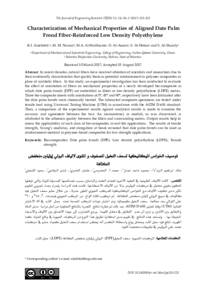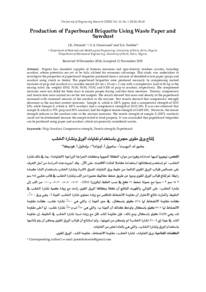وثيقة
Characterization of mechanical properties of aligned date palm frond fiber-reinforced low density polyethylene.
المساهمون
الناشر
Sultan Qaboos University.
ميلادي
2017
اللغة
الأنجليزية
الملخص الإنجليزي
In recent decades, natural fibers have received attention of scientists and researchers due to their ecofriendly characteristics that qualify them as potential reinforcement in polymer composites in place of synthetic fibers. In this study, an experimental investigation has been conducted to evaluate the effect of orientation of fibers on mechanical properties of a newly developed bio-composite in which date palm fronds (DPF) are embedded as fibers in low-density polyethylene (LDPE) matrix. Three bio-composite sheets with orientations of 0°, 45° and 90°, respectively have been fabricated after the date palm fronds were chemically treated. The fabricated composite specimens are tested under tensile load using Universal Testing Machine (UTM) in accordance with the ASTM D-638 standard. Then, a comparison of the experimental results against analytical results is made to examine the accuracy and agreement between the two. An inconsistency in moduli, as was discovered, is attributed to the adhesion quality between the fibers and surrounding matrix. Output results help to assess the applicability of such class of bio-composites in real-life applications. The results of tensile strength, Young's modulus, and elongation at break revealed that date palm fronds can be used as reinforcement material in polymer-based composites for low strength applications.
المجموعة
ISSN
1726-6742
URL المصدر
zcustom_txt_2
Alzebdeh, K. I., Nassar, M. M., Al-Hadhrami, M. A., Al-Aamri, O., Al-Defaai, S., & Al-Shuaily, S. (2017). Characterization of mechanical properties of aligned date palm frond fiber-reinforced low density polyethylene. The Journal of Engineering Research,
الملخص العربي
لاقت الألياف الطبيعية في العقود الأخيرة اهتمام العلماء والباحثين بسبب خصائصها الصديقة للبيئة والتي تؤهلها لتكون مقوي محتمل في مركبات البوليمر بدلا من الألياف الاصطناعية. قامت هذه الدراسة بإجراء بحث تجريبي لتقييم تأثير مدى تكيف الألياف مع الخواص الميكانيكية للمركب الحيوي المطور حديثا، من خلال حشو سعف النخيل فيه كألياف في نسيج البولي إثيلين منخفض الكثافة. تم تركيب ثلاثة ألواح من المركب الحيوي بقياسات 0 °، 45 ° و 90 ° على التوالي بعد معالجة سعف النخيل كيميائيا. وتم اختبار عينات المركب المصنعة تحت حمل الشد في آلة الاختبار العالمية (UTM) وفقا لمعايير ASTM D-638. بعد ذلك تم مقارنة نتائج التجربة بالنتائج التحليلية من أجل دراسة مدى الدقة والتطابق بين الاثنين. وتبين أن عدم التطابق في معامل القيمة يرجع التضارب إلى جودة الاتصاق بين الألياف والأنسجة المحيطة بها. وتساعد هذه النتائج في تقييم مدى إمكانية تطبيق هذا النوع من المركبات الحيوية في واقع الحياة. كما أظهرت نتائج قوة حمل الشد ومعامل يونغ واستطالة الكسر أنه يمكن استخدام سعف النخيل كمواد حشو في مركبات تعتمد على البوليمر في تطبيقات منخفضة القوة.
قالب العنصر
مقالات الدوريات


